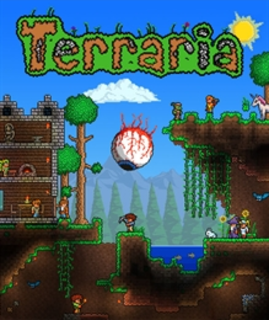2D Platforming + Sandbox + Action RPG = Awesome!
Terraria is fast approaching a huge milestone as it's total sales soars ever closer to 500,000. Joining an elite group of indie games, Re-Logic's sandbox-platformer-adventure game is no where close to slowing down either. Originally supported by Minecraft's Notch, most new players saw the game as a sidescrolling Minecraft, and like most Minecraft afficionados, I too approached Terraria as a sandbox building game. Quite frankly, it's easy to see why: monsters come out at night, you dig with a pickaxe and mine a variety of ores, and the deeps are catacombed with mysterious caves, tunnels, and dungeons. However, it didn't take long for me to realize that Terraria is a rather different type of game.
In the first place, Terraria is a 2D sidescrolling platformer. Though it may not sound like that wouldn't make much of a difference, it ultimately overdetermines the entire experience. Rather than exploring a vast world of varying environments, in Terraria your surface exploration is ultimately much more limited. Yes, there are a few different ecosystems – primarily a grassy tree-lined healthy world and an infected thorn-lined counterpoint – but exploration is much more about vertical than horizontal exploration. Such verticalization is instrumental in Terraria's approach to the sandbox medium, because rather than simply explore, build, and create as one would in Minecraft, the experience is much closer to traditional adventure games. As you descend into the depths of Terraria, you'll not only encounter different geologic strata but also more difficult monsters. Additionally, you'll eventually summon huge demon bosses which are brutal fights especially early on. On the whole, there's quite a bit of combat in Terraria; though the surface monsters are pretty weak the beasts you encounter as you decend can be really tricky, and they're all over the place. As you mine better ores, however, you'll be able to equip better armor and weapons, and eventually be able to cast spells too – all of which makes Terraria feel much more like an action-RPG at times. Chests scattered about the underworld carry life-bonuses in addition to powerful weapons and accessories which allow for double-jumping and other perks. In other words, action isn't secondary by any means here, but is rather at the core of the experience. In fact, I'd almost go so far as to say that Terraria is more of an action-adventure game similar to Castlevania than a sandbox world a la Minecraft. The whole experience pushes you towards improving your gear and digging ever deeper into the depths.
Yet, there's clearly a strong sandbox element to the play as well. With chopped wood and mined ores you can build giant castles with rooms that spawn NPCs which will help you in your travels, including vendors and healers. With components you craft you can make chandeliers and tables as well as buckets (for a helmet or transporting liquid) as well as windows and potions and even plant trees from seedlings. Despite all the fighting you'll do, there's still a very real sense that you're making your home in this world and have the resources to construct to your heart's content. It's not as gratifying as Minecraft, primarily because all the structures are simply 2D, but that doesn't mean you can't have your fun this way too.
Like Minecraft, the aesthetic dimensions of the game are defined more by pragmatic concerns (recognizing ores and platforming objects) than by a strong sense of atmosphere. Terraria does the job well to this extent, as the different geological strata and environments are quickly recognizable if not deeply artistic. While there are moments of exploration that deliver a few "wow" moments, for instance the first time you encounter glowing mushrooms, for the most part exploration relies more on substance than on style. I do need to give the musical score some props, as though it can get repetitive, it delivers a unique scoring for the game and does a good job of syncing with environmental factors like coming to to the surface or day to night circulation. Though some of the monster sounds become rather grating (especially zombies which sound like they're coughing all the time) for the most part it's well executed and adds to the overall experience.
On the whole, Terraria is simply a terrific game. It delivers hours and hours of compelling play at a great price, and the combination of combat-centric play with sandbox sensibilities is a clear winner. There's a strong feeling of growing ever more powerful in order to meet the ever greater demands of exploration, and though the balance seems dodgy in the early hours, once you get going there's quite a lot to like. Though Terraria is a much more progressive and focused experience than Minecraft, what it offers is clearly exceptional and should satisfy anyone remotely interested in sandbox games or classic sidescrolling action enthusiasts who don't mind taking their time to beef up. Terraria is easily one of the best games, and certainly best indie games, to surface this year. Once you submerge yourself, however, you may not come up.

